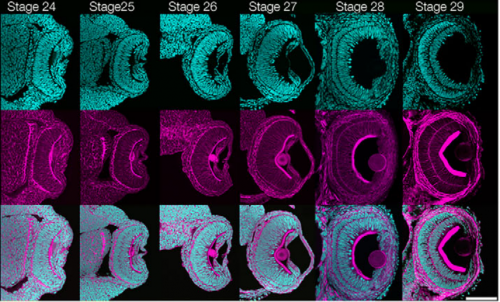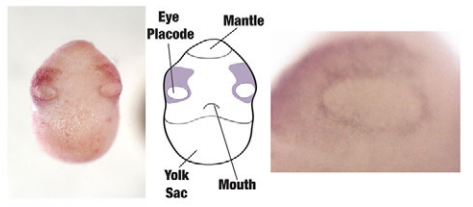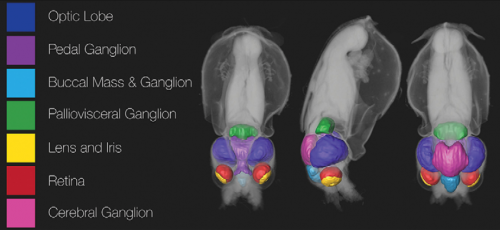The people behind the papers: Kristen Koenig & Jeffrey Gross
Posted by the Node Interviews, on 2 September 2016
Today’s paper is from the latest issue of Development and introduces the squid Doryteuthis pealeii as a lophotrochozoan model for eye development. And the people are PI Jeffrey Gross, Director of the Louis J. Fox Center for Vision Restoration and Professor of Ophthalmology and Developmental Biology at the University of Pittsburgh, and lead author Kristen Koenig, who has recently started her own lab at the FAS Centre for Systems Biology at Harvard University.

So Jeffrey, can you give us the brief history of the Gross lab, and what key questions your group is trying to answer?
JG I started the lab 11 years ago at the University of Texas at Austin, and we moved about a year ago to the University of Pittsburgh Medical School. We’re broadly interested in eye development and diseases. Major questions in the lab focus on optic cup morphogenesis, the epigenetic regulation of retinal and retinal pigment epithelium development and regeneration.
To be honest, we’re rather unfocused, which I think is great! I encourage the students and postdocs in the lab to come up with their own questions and interests and then to go for them; this is the way I was trained as a Ph.D. student with Dave McClay, and I think it is the best way for Ph.D. students and postdocs to learn how to do science. As a result, we’ve worked on a fairly diverse set of questions over the time I’ve had the lab and it really makes this is a fun job.
“I encourage the students and postdocs in the lab to come up with their own questions and interests and then to go for them; this is the way I was trained as a Ph.D. student with Dave McClay, and I think it is the best way for Ph.D. students and postdocs to learn how to do science.”
And Kristen: how did you come to join the Gross lab?
KK I decided to go to the University of Texas for graduate school because it seemed like an exciting research environment that had all the scientific resources one could want but was not a competitive or negative place to work. When choosing the Gross lab, I knew I wanted to study evolutionary questions but I was also concerned with generating a positive relationship with my advisor. The eye is an excellent system to study the evolution and development of complexity and Jeff was amazingly supportive of crazy ideas so it was a good fit. Also, the developmental biology community at UT was and still is a really exciting and supportive group of researchers.

While your lab usually works on zebrafish, your Development paper focuses on eye development and photoreceptor differentiation in the longfin inshore squid (Doryteuthis paeleii). So why cephalopods, and this squid in particular, for this project?
JG I’ve always been interested in evo-devo work and wanted us to do some work on eye evolution, but this project really didn’t start until Kristen Koenig joined the lab as a Ph.D. student. The squid project was her idea and I just provided some advice on getting it started – she’s really the brains of the operation!
There is a long history of research using Doryteuthis pealeii at the Marine Biological Laboratory (MBL) in Woods Hole, MA and there is terrific infrastructure for collecting adults and obtaining gametes at the Marine Resources Center at the MBL. Moreover, Kristen and I have spent a significant amount of time at the MBL, which is truly a magical place, so it made a lot of sense to use the resources there and our connections to build Doryteuthis pealeii as a model. There are also worse places in the world than Woods Hole to have to spend a summer working in the lab!
“They are definitely charismatic embryos. It is a pleasure to look at them for as long as I do.”
What’s it like working with squid? They look kind of cute…
KK Doryteuthis pealeii are great to work with. They are a good size, develop at a reasonable pace, they are abundant and resilient to manipulations. Their eyes are quite large during development so for someone interested in visual systems they are quite exciting organisms. As you mentioned, they are definitely charismatic embryos. It is a pleasure to look at them for as long as I do.

And you get the embryos from Woods Hole?
KK Yes. During most of my dissertation work I spent every summer at the Marine Biological Labs in Woods Hole. As Jeff mentioned, the Marine Resources Center there has an excellent capacity to provide access to adult squid and their eggs. Without the MRC, none of this work would have been possible. I only have embryos during the summer months so I have to plan my experiments for the year during that time.
Could you give us the paper’s key results in a short paragraph?
JG, KK Our research interest is to better understand visual system evolution across the Bilateria from a developmental perspective. We established the squid, Doryteuthis pealeii, as a lophotrochozoan model for complex eye development. Utilizing histological, transcriptomic and molecular assays we characterized eye formation in Doryteuthis pealeii. Through lineage tracing and gene expression analyses, we demonstrated that cells expressing Pax and Six genes incorporate into the lens, cornea and iris tissue, suggesting a convergent involvement in lens formation. We identified the sole source of retinal tissue in the squid and functional assays demonstrated that Notch signaling is required for photoreceptor cell differentiation and retina organization. These assays support a conserved role for notch signaling in neurogenesis in the cephalopod eye.

Were there any particularly surprising results that came out of the lineage tracing?
JG, KK Our lineage tracing showed that the cells generating the optic lobe originated from a different place than originally thought. This ultimately has consequences on how we interpret gene expression at these early stages and also suggests that these cells might be migrating to incorporate into the developing optic lobes.
I’m wondering about the question of conservation or convergence (of photoreceptor cell types and the molecular pathways that generate them, in metazoa). What does your work bring to the debate?
JG, KK The photoreceptor cells in the squid retina are rhabdomeric and express r-opsins. There is still a lot to understand about the molecular pathways that generate these cells to enable gene regulatory network comparisons across organisms. Our work supports a role for notch signalling during neurogenesis within the squid retina. This may illuminate a conserved function for notch within pseudostratified neuroepithelia.
“Just seeing the basics of eye morphogenesis continues to blow my mind.”
Was there any part of the work you were most proud of?
KK That’s a tough question because each part of the project presented its own set of unique challenges. The part I still think about regularly is the staging series of eye formation. Just seeing the basics of eye morphogenesis continues to blow my mind. There is so much information in those images and when I look at them it only generates more curiosity and questions.

And any part of the work that was particularly frustrating or intractable?
KK Some parts of the lineage tracing were challenging. The experiment consisted of hundreds of embryos and had many steps and it was important to keeping track of every individual embryo at each step. Also, half way through the experiment I had to trust the mail delivery system that my specimens wouldn’t get stalled in transit back to Texas and melt into a sad pool of defeat. In the end I knew the experiment was possible but it was just very important to stay consistently focused and organized.
And you’ve left the Gross lab now? What’s next for you?
KK Yes, I just recently left Texas. I am now at the FAS Center for Systems Biology at Harvard University. I am a John Harvard Distinguished Science Fellow and am starting my own lab continuing to study squid eye formation and the evolution and development of visual systems more broadly.
Now you have this squid developmental resource, any future plans to carry on with Doryteuthis? What do you want to know now?
JG I hope to, if Kristen doesn’t mind letting me squat in her lab at Harvard from time to time! The way the lens develops in the squid is fascinating, and I think the cell biology underlying this will be fun to study. I hope that we’ll be able to take a look at this in more detail over the next few summers, and use some of the molecular and imaging tools that Kristen has developed to drill down to the mechanism.


 (4 votes)
(4 votes)